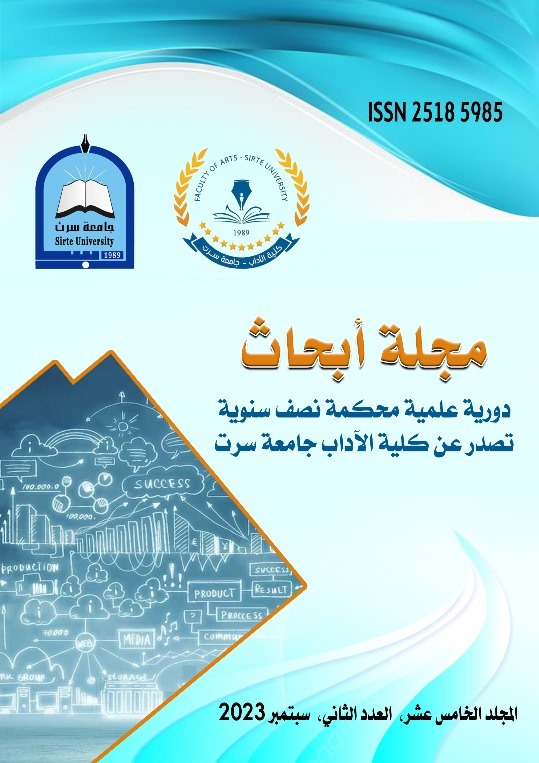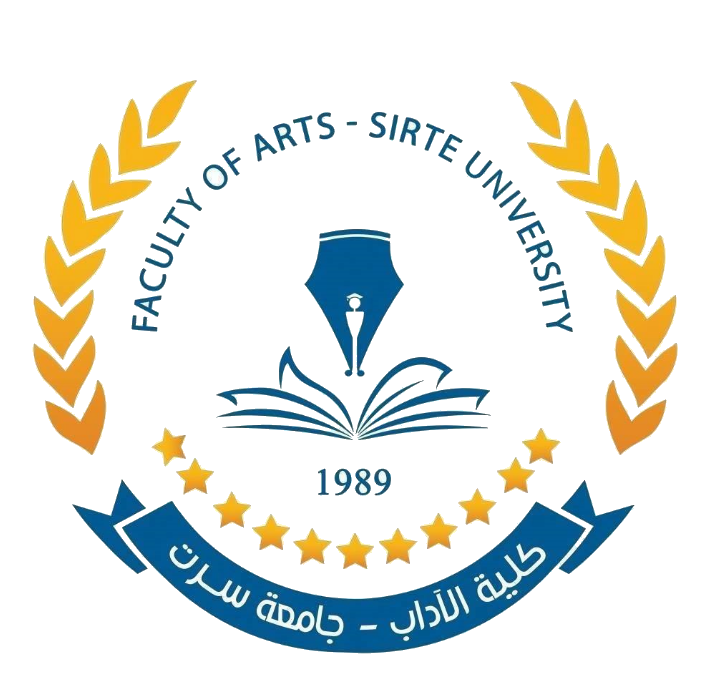Learner Awareness of Recasts in Classroom Interaction: Analysis of Empirical Research in L2 Classroom
DOI:
https://doi.org/10.37375/abhat.v15i2.1652الكلمات المفتاحية:
Corrective feedback، Recast، Saliency، noticeabilityالملخص
In the past two decades, there have been a number of research studies that found positive impacts of different types of recasts on learning a range of linguistic forms. This review analyzes the existing empirical research studies about the learners' awareness of teacher recasts in L2 classroom i¬nteraction. Furthermore, it focuses on the debate about the role of recast in learning a second language. While some researchers have criticized teacher recast as inefficient, unnoticeable, and ambiguous, others have described it as useful and effective in improving learners' accuracy. Some found that teacher recast may be perceived by learners as a confirmation of meaning rather than form (Lyster, 1998). This review helps pinpoint the factors (i.e. noticeability, learners' proficiency level, etc.) that contribute to the effec-tiveness of teacher recast. Researchers have yet clearly identified the differ-ential benefits that teacher recast may show in comparison to other forms of corrective feedback
المراجع
- Alavi, S. S., Foo, T. C. V., & Amini, M. (2015). L2 learners’ proficiency development through noticing feedback. International Journal of Multicultural and Multireligious Understanding, 2(5), 25-41.
- Ammar, A., & Spada, N. (2006). One size fits all? Recasts, prompts, and L2 learning. Studies in Second Language Acquisition, 28(4), 543–574.
- Ammar, A. & Sato, M. (2010). The importance of noticing in meaning-oriented second language classrooms. Paper presented at the 10th International Conference of the Association for Language Awareness, University of Kassel, Germany.
- Asari, Y. O. K. O. (2012). Types of recasts and learners’ uptake. Dialogue, 10, 1-20.
- Ayoun, D., (2004) The effectiveness of written recasts in the second language acquisition of aspectual distinctions in French: A follow-up study. Modern Language Journal, 88, 31-55.
- Batstone, R. (1996). Key concepts in ELT. ELT Journal, 50(3), 273.
- Braidi, S. M. (2002). Reexamining the role of recasts in native-speaker/ nonnative-speaker interactions. Language Learning, 52, 1-42.
- Carroll, S., & Swain, M. (1993). Explicit and implicit negative feedback: An empirical study of the learning of linguistic generalizations. Studies in Second Language Acquisition, 15, 357–386.
- Chaudron, C. (1977). A descriptive model of discourse in the corrective treatment of learners' errors. Language learning, 27(1), 29-46.
- Dörnyei, Z. (2009). Psychology of second language acquisition. Oxford: Oxford University Press.
- Doughty, C. J., & Varela, E. (1998). Communicative focus on form. In C. J. Doughty & J. Williams (Eds.), Focus on form in classroom second language acquisition (pp. 114–138). New York: Cambridge University Press.
- Doughty, C. (2001). Cognitive underpinnings of focus on form. In P. Robinson (Ed.), Cognition and second language instruction (pp. 206–257). Cambridge, UK: Cambridge University Press.
- Egi, T. (2007). Interpreting recasts as linguistic evidence: The roles of linguistic target, length, and degree of change. Studies in Second language acquisition, 29(4), 511-537.
- Ellis, R. (2006). Current issues in the teaching of grammar: An SLA perspective. TESOL quarterly, 40(1), 83-107.
- Ellis, R. (2004). Individual differences in second language learning. In A. Davies & C. Elder (Eds.), The handbook of applied linguistics (pp. 525–551). Oxford: Blackwell.
- Ellis, R., & Sheen, Y. (2006). Re-examining the role of recasts in L2 acquisition. Studies in Second Language Acquisition, 28, 576–600.
- Ellis, R., Loewen, S., & Erlam, R. (2006). Implicit and explicit corrective feedback and the acquisition of L2 grammar. Studies in Second Language Acquisition, 28, 339-368.
- Ellis, R., Basturkmen, H., & Loewen, S. (2001). Learner uptake in communicative ESL lessons. Language learning, 51(2), 281-318.
- Farrokhi, F., & Chehrazad, M. H. (2012). The Effects of Planned Focus on Form on Iranian EFL Learners' Oral Accuracy. World Journal of education, 2(1), 70-81.
- Fukuya, Y., & Zhang, Y. (2002). Effects of recasts on EFL learners’ acquisition of pragmalinguistic conventions of request. Second language studies, 21(1), 1-47.
- Gass, S. (1997). Input, interaction, and the language learner. Mahwah, NJ: Lawrence Erlbaum.
- Gass, S. M., & Mackey, A. (2015). Input, interaction, and output in second language acquisition. In B. VanPatten, & J. Williams (Eds.), Theories in second language acquisition (pp. 180–206). New York, NY: Routledge.
- Goo, J. (2012). Corrective feedback and working memory capacity in interaction-driven L2 learning. Studies in Second Language Acquisition, 34, 445–474.
- Godfroid, A., Boers, F., & Housen, A. (2013). An eye for words: Gauging the role of attention in incidental L2 vocabulary acquisition by means of eye-tracking. Studies in Second Language Acquisition, 35(3), 483-517.
- Han, Z. (2002). A study of the impact of recasts on tense consistency in L2 output. TESOL Quarterly, 36, 542–572.
- Havranek, G. (1999). The effectiveness of corrective feedback: Preliminary results of an empirical study. Acquisition et Interaction en Langue Étrangère, 2, 189–206.
- Hernández Méndez, E., & Reyes Cruz, M. D. R. (2012). Teachers' perceptions about oral corrective feedback and their practice in EFL classrooms. Profile Issues in Teachers Professional Development, 14(2), 63-75.
- Horwitz, E. K., Horwitz, M. B., & Cope, J. (1986). Foreign language classroom anxiety. The Modern language journal, 70(2), 125-132.
- Leeman, J. (2003). Recasts and second language development: Beyond negative evidence. Studies in Second Language Acquisition, 25 (1), 37–63.
- Li, S. (2013). The interactions between the effects of implicit and explicit feedback and individual differences in language analytic ability and working memory. The Modern Language Journal, 97(3), 634–654.
- Lightbown, P. M., & Spada, N. (2021). How Languages Are Learned 5th Edition. Oxford. Oxford university press.
- Loewen, S. (2004). Uptake in incidental focus on form in meaning‐focused ESL lessons. Language learning, 54(1), 153-188.
- Leow, R. P. (2000). A study of the role of awareness in foreign language behavior: Aware versus unaware learners. Studies in second language acquisition, 22(4), 557-584.
- Loewen, S., & Philp, J. (2006). Recasts in the adult L2 classroom: characteristics, explicitness and effectiveness. Modern Language Journal, 90, 536-556.
- Loewen, S., & Sato, M. (2018). Interaction and instructed second language acquisition. Language Teaching, 51(3), 285–329.
- Long, M. (1996). The role of the linguistic environment in second language acquisition. Handbook of second language acquisition.
- Long, M. H. (2007). Problems in SLA. Mahwah, NJ: Lawrence Erlbaum Associates.
- Long, M. H. (2015). Second language acquisition and task-based language teaching. Malden, MA: Wiley-Blackwell.
- Lyster, R (1998). Recasts, repetition and ambiguity in L2 classroom discourse. Studies in Second Language Acquisition, 20 (1), 51-81.
- Lyster, R., (2004) Differential effects of prompts and recasts in form-focused instruction. Studies in Second Language Acquisition, 26, 399–432.
- Lyster, R., & Ranta, L. (1997). Corrective feedback and learner uptake: Negotiation of form in communicative classrooms. Studies in Second Language Acquisition, 19(1), 37–66.
- Lyster, R., & Mori, H. (2006). Interactional feedback and instructional counterbalance. Studies in Second Language Acquisition, 28, 321–341.
- Lyster, R., Saito, K., & Sato, M. (2013). Oral corrective feedback in second language classrooms.
- Mackey, A. (2006). Feedback, noticing and instructed second language learning. Applied Linguistics, 27 (3), 405-430.
- Mackey, A. (2012). Input, interaction, and corrective feedback in L2 learning. Oxford, UK: Oxford University Press.
- Mackey, A., & Philp, J. (1998). Conversational interaction and second language development: Recasts, responses, and red herrings? The modern language journal, 82(3), 338-356.
- Mackey, A., Gass, S., & McDonough, K. (2000). How do learners perceive implicit negative feedback? Studies in Second Language Acquisition, 22, 471–497.
- Mifka-Profozic, N. (2013). The effectiveness of corrective feedback and the role of individual differences in language learning.
- Nabei, T., & Swain, M. (2002). Learner awareness of recasts in classroom interaction: A case study of an adult EFL student’s second language learning. Language Awareness, 11 (1), 43-63.
- Nassaji, H. (2007). Elicitation and reformulation and their relationship with learner repair in dyadic interaction. Language Learning, 57(4), 511–548.
- Nassaji, H. (2009). Effects of recasts and elicitations in dyadic interaction and the role of feedback explicitness. Language Learning, 59(2), 411–452.
- Nicholas, H., Lightbown, P. M., & Spada, N. (2001). Recasts as feedback to language learners. Language Learning, 51(4), 719–758.
- Ohta, A. (2000). Rethinking recasts: A learner-centered examination of corrective feedback in the Japanese classroom in JK Hall and L. Verplaetse (Eds.): The construction of second and foreign language learning through classroom interaction.
- Oliver, R. (1995). Negative feedback in child NS-NNS conversation. Annotations Theme Studies in Second Language Acquisition, 17(4), 459–481.
- Oliver, R. (2000). Age differences in negotiation and feedback in classroom and pairwork. Language Learning, 50, 119–151.
- Panova, I., & Lyster, R. (2002). Patterns of corrective feedback and uptake in an adult ESL Classroom. TESOL Quarterly, 36(4), 573–595.
- Philp, J. (2003). Constraints on ‘Noticing the gap’: Nonnative speakers’ noticing of recasts in NS-NNS interaction. Studies in Second Language Acquisition, 25(1), 99–126.
- Philp, J., & Mackey, A. (2010). Interaction research: What can socially informed approaches offer to cognitivists (and vice versa)? In R. Batstone (Ed.), Sociocognitive perspectives on language use and language learning (pp. 210–224). Oxford: Oxford University Press.
- Rassaei, E. (2014). Scaffolded feedback, recasts, and L2 development: A sociocultural perspective. The modern language journal, 98(1), 417-431.
- Sato, M. (2011). Constitution of form-orientation: Contributions of context and explicit knowledge to learning from recasts. The Canadian Journal of Applied Linguistics, 14(1), 1–28.
- Sawyer, M., & Ranta, L. (2001). Aptitude, individual differences, and instructional design. In P. Robinson (Ed.), Cognition and second language instruction (pp. 319–353). New York: Cambridge University Press.
- Schmidt, R. (1995). Consciousness and foreign language learning: A tutorial on the role of attention and awareness in learning. In R. Schmidt (Ed.), Attention and awareness in foreign language learning (pp. 1–66). Honolulu: University of Hawaii at Manoa. - Sheen, Y. (2004). Corrective feedback and learner uptake in communicative classrooms across instructional settings. Language teaching research, 8(3), 263-300.
- Sheen, Y. (2006). Exploring the relationship between characteristics of recasts and learner uptake. Language Teaching Research, 10, 361-392.
- Sheen, Y. (2007). The effect of focused written corrective feedback and language aptitude on ESL learners' acquisition of articles. TESOL quarterly, 41(2), 255-283.
- Skehan, P. (2002). Theorising and updating aptitude. In P. Robinson (Ed.), Individual differences and instructed language learning (pp. 69–93). Amsterdam: Benjamins.
- Swain, M., & Lapkin, S. (1998). Interaction and second language learning: Two adolescent French immersion students working together. The modern language journal, 82(3), 320-337.
- Taddarth, A. (2010). Recasts, uptake and learning: Effects and relationships. Unpublished Master’s thesis, University of Montreal.
- Tomlin, R. S., & Villa, V. (1994). Attention in cognitive science and second language acquisition. Studies in second language acquisition, 16(2), 183-203.
- Truscott, J. (1999). What’s wrong with oral grammar correction. Canadian Modern Language Review, 55, 437-456.

















